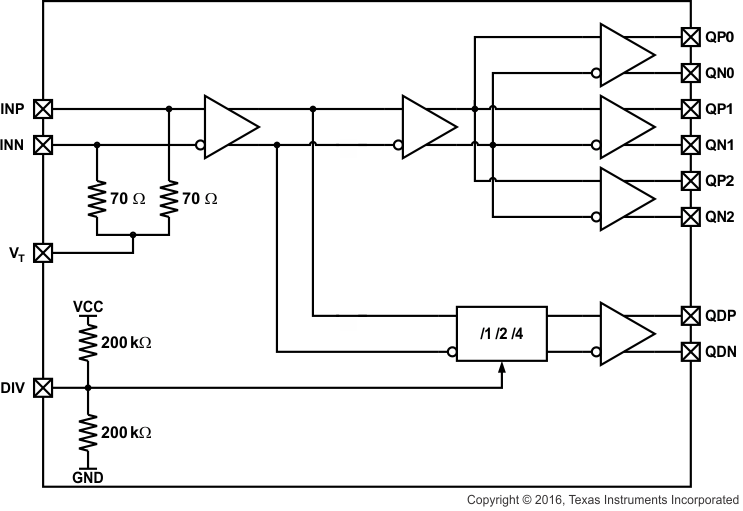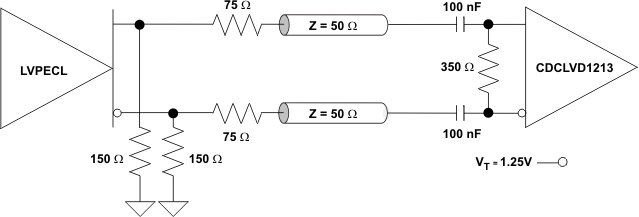SCAS897A July 2010 – October 2016 CDCLVD1213
PRODUCTION DATA.
- 1 Features
- 2 Applications
- 3 Description
- 4 Revision History
- 5 Pin Configuration and Functions
- 6 Specifications
- 7 Parameter Measurement Information
- 8 Detailed Description
- 9 Application and Implementation
- 10Power Supply Recommendations
- 11Layout
- 12Device and Documentation Support
- 13Mechanical, Packaging, and Orderable Information
8 Detailed Description
8.1 Overview
The CDCLVD1213 LVDS drivers use CMOS transistors to control the output current. Therefore, proper biasing and termination are required to ensure correct operation of the device and to maximize signal integrity.
The proper LVDS termination for signal integrity over two 50-Ω lines is 100 Ω between the outputs on the receiver end. Either DC-coupled termination or AC-coupled termination can be used for LVDS outputs. TI recommends placing a termination resistor close to the receiver. If the receiver is internally biased to a voltage different than the output common-mode voltage of the CDCLVD1213, AC-coupling must be used. If the LVDS receiver has internal 100-Ω termination, external termination must be omitted.
8.2 Functional Block Diagram

8.3 Feature Description
The CDCLVD1213 is a low additive jitter LVDS fan-out buffer that can generate four copies of an LVPECL, LVDS, or CML input, one of which can be frequency divided by a factor of 1, 2, or 4. The CDCLVD1213 can accept reference clock frequencies up to 800 MHz while providing low output skew.
8.4 Device Functional Modes
The divider on output QD can be configured to divide the input frequency by a factor 1, 2, or 4 through the control pin (see Table 1). Unused outputs can be left floating to reduce overall component cost. Both AC- and DC-coupling schemes can be used with the CDCLVD1213 to provide greater system flexibility.
Table 1. Divider Selection Table
| DIV | DIVIDER RATIO |
|---|---|
| 0 | /1 |
| open | /2 |
| 1 | /4 |
8.4.1 LVDS Output Termination
Unused outputs can be left open without connecting any traces to the output pins.
The CDCLVD1213 can be connected to LVDS receiver inputs with DC- and AC-coupling as shown in Figure 9 and Figure 10 (respectively).
 Figure 9. Output DC Termination
Figure 9. Output DC Termination
 Figure 10. Output AC Termination (With the Receiver Internally Biased)
Figure 10. Output AC Termination (With the Receiver Internally Biased)
8.4.2 Input Termination
The CDCLVD1213 input has an internal 140-Ω termination and can be interfaced with LVDS, LVPECL, or CML drivers. An external 350-Ω resistor (in parallel with the internal 140-Ω termination) is required to interface with a 50-Ω transmission line.
LVDS drivers can be connected to CDCLVD1213 inputs with DC- and AC-coupling as shown in Figure 11 and Figure 12 (respectively). With AC coupling, an external bias voltage (VCC/2) must be provided to the VT pin.
 Figure 11. LVDS Clock Driver Connected to CDCLVD1213 Input (DC-Coupled)
Figure 11. LVDS Clock Driver Connected to CDCLVD1213 Input (DC-Coupled)
 Figure 12. LVDS Clock Driver Connected to CDCLVD1213 Input (AC-Coupled)
Figure 12. LVDS Clock Driver Connected to CDCLVD1213 Input (AC-Coupled)
Figure 13 illustrates how to connect a CML input to the CDCLVD1213 input buffer. The input does not have internal biasing, so external biasing (VCC/2 to VT) is required for AC coupling. If the CML output swing is >1.6 VPP, then signal swing must be reduced to meet VIN, DIF, PP ≤ 1.6 VPP.
 Figure 13. CML Clock Driver Connected to CDCLVD1213 Input
Figure 13. CML Clock Driver Connected to CDCLVD1213 Input
Figure 14 illustrates how to connect an LVPECL input to the CDCLVD1213 input buffer. The input does not have internal biasing, so external biasing (VCC/2 to VT) is required for AC coupling. The series resistors are required to reduce the LVPECL signal swing if the signal swing is >1.6 Vpp.
 Figure 14. LVPECL Clock Driver Connected to CDCLVD1213 Input
Figure 14. LVPECL Clock Driver Connected to CDCLVD1213 Input